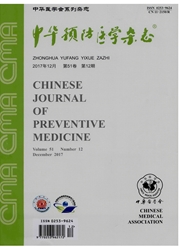

 中文摘要:
中文摘要:
目的探讨转录因子E2F1和E2F4在维生素c逆转苯并(a)芘引起人胚肺成纤维细胞(HELF)细胞周期改变中的作用,及其与细胞周期蛋白D1(cyclin D1)、细胞周期蛋白依赖激酶4(CDK4)的上下游关系。方法接种细胞到培养瓶,待生长至70%一80%时,维生素c预处理细胞1h后,用苯并(a)芘刺激细胞24h,运用流式细胞术测定细胞周期时相分布,用免疫印迹法检测蛋白含节,用Gel-Pro 3.0软件对条带光强度进行分析,脂质体转染法建立稳定转染反义cyclin D1或反义CDK4的HELF系,应用反义技术证明通路的上下游关系。结果苯并(a)芘诱导HELF中cyclin D1、CDK4、E2F1和E2F4的蛋白表达升高,并伴随s期细胞百分率从(33.5±3.2)%上升至(41.1±0。2)%。维生素C可降低苯并(a)芘诱导的HELFS期细胞百分率至(33.2±0.6)%,并抑制苯并(a)芘诱导的HELF上述蛋白的表达。反义cyclin D1和反义CDK4均可抑制苯并(a)芘诱导的HELF上述蛋白的表达,反义cyclinD1可使苯并(a)芘诱导的HELFS期细胞百分率降低至(31.2±1.3)%。维生素C联合反义cyclinD1与单独反义cyclinD1相比,可进一步降低苯并(a)葩诱导的HELF上述蛋白的表达,且能够抑制苯并(a)芘诱导的HELF的s期细胞百分率,使其从(41.1±0.2)%下降为(34.0±0.3)%。维生素c联合反义CDK4可降低苯并(a)芘诱导的HELF的s期细胞百分率,使其从(41.1±0.2)%下降为(33.7±1.5)%,而且与单独反义CDK4相比,可进一步降低苯并(a)芘诱导的HELF的s期细胞百分率。结论维生素C可能通过cyclinD1-CDK4/E2F-1/4通路逆转苯并(a)芘引起的细胞周期改变。
 英文摘要:
英文摘要:
Objective To study the role of E2F1/4 pathway in vitamin C reversing benzo (a) pyrene [ B(a)P]-induced changes of cell cycle in human embryo lung fibroblasts (HELF) and the relationship between E2F1 and cyclin D1/CDK4. Methods The stable transfectants, HELF transfected with antisense cyclin D1 and antisense CDK4, were established to detect the relationship of signaling pathway. Cells were cultured and pretreated with vitamin C before stimulation with B(a) P for 24 hours. The expression levels of cyclin D1, CDK4, E2F1 and E2F4 were determined by Western blot and the band intensity was analysed as the relative value to control by using the Gel-Pro 3.0 software. Flow Cytometric Analysis was employed to detect the distributions of cell cycle. Results B(a) P significantly elevated the expression levels of cyclin D1, CDK4, E2F1 and E2F4 in HELF cells. Vitamin C decreased the expression levels of above proteins in B(a) P-stimulated HELF cells. The expression levels of these proteins in B(a) P-treated above transfectants were lower than those in B(a) P-treated HELF cells. The expression levels of above proteins with vitamin C combined with antisense cyclin DI were decreased as compared to those with antisense cyclin D1 alone. B(a)P increased the percentage of S phase as compared to the controls [ (41. 1 ± 0. 2)% vs (33.5 ± 3,2)%, P〈0.05], Both vitamin C [(33.2 ±0.6)% vs (41.1 ±0.2)%, P〈0.05] and antisense cyclin D1 [ (31.2 ± 1.3) % vs (41.1 ± 0. 2 ) %, P 〈 0. 05 ] suppressed the changes of cell cycle induced by B(a) P, Vitamin C combined with antisense CDK4 markedly suppressed B( a) P-induced changes of cell cycle as compared to those with antisense CDK4 alone. Conclusion Vitamin C might reserve the B(a) P- induced changes of cell cycle via intracellular signaling pathway of cyclin D1-CDK4/E2F-1/4.
 同期刊论文项目
同期刊论文项目
 同项目期刊论文
同项目期刊论文
 期刊信息
期刊信息
